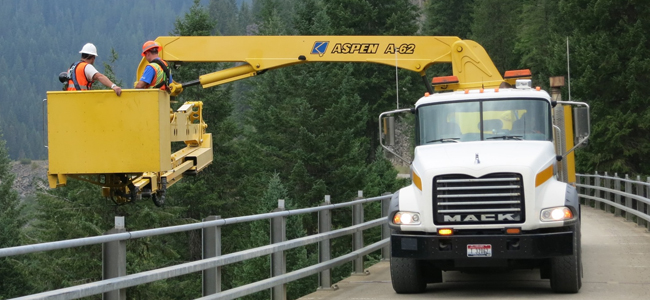

Almost 1,100 bridges qualify for inspections every four years
For years, the bridge-inspection mantra has been "at least every two years, and more frequently if needed." Now, we can add to that, "and less often, when warranted."
As of February, the old two-year cycle for routine inspections recently became a four-year cycle for a limited number of bridges in good condition, that are not posted for legal loads, and meet a number of other conditions.
As before, bridges will still be inspected more frequently if conditions warrant a more regular inspection. Bridges in fair and satisfactory condition will remain on a two-year frequency.
"We need to focus our time and assets as effective and efficiently as possible," ITD Bridge Asset Management Engineer Dan Gorley said, "and this is a step in the right direction."
Approximately 26 percent of the bridges owned by the state and local public agencies statewide meet the conditions described in the four-year policy. Currently, 524 state bridges qualify and 570 local bridges qualify — 1,094 of 4,220 bridges.
This change represents the Bridge section's efforts to improve efficiency and focus resources, while maintaining or improving safety on the State and Local systems. Bridges must meet certain criteria in order to extend their inspection frequency to greater than every two years.
This adjustment in frequency provides the ability to work more efficiently with local bridge funds and resources. Additionally, the change allows the inspectors more time to focus on the higher-risk bridges. 
Prior to implementing the change in inspection frequency for bridges meeting the qualifying criteria on the local system, the Bridge section asked local bridge owners if they agreed and or wanted to comment on the changes. ITD received no dissenting comments. The Federal Highway Administration also concurred with the change.
"The change allows the inspectors more time to focus on the higher-risk bridges," explained State Bridge Engineer Matt Farrar. "The realigned resources that result from the new 48-month policy will enable us to perform more in-depth inspection on key components of bridges."
Farrar mentioned the in-depth inspections of pin and hanger assemblies connecting two plate girders on some bridges, or overhead cable saddles on the Dent Bridge spanning the Dworshak Reservoir on the North Fork of the Clearwater River north of Orofino.
Pictured right: Osprey nest removal at the Dent Bridge in fall 2014, after the birds had flown south.
For example, the section has already shifted resources in consultant inspection contracts to use for measuring bridges with no plans for load rating and to perform supplemental special inspections due to Osprey nesting issues on the Dent Bridge.
Published 05-15-15